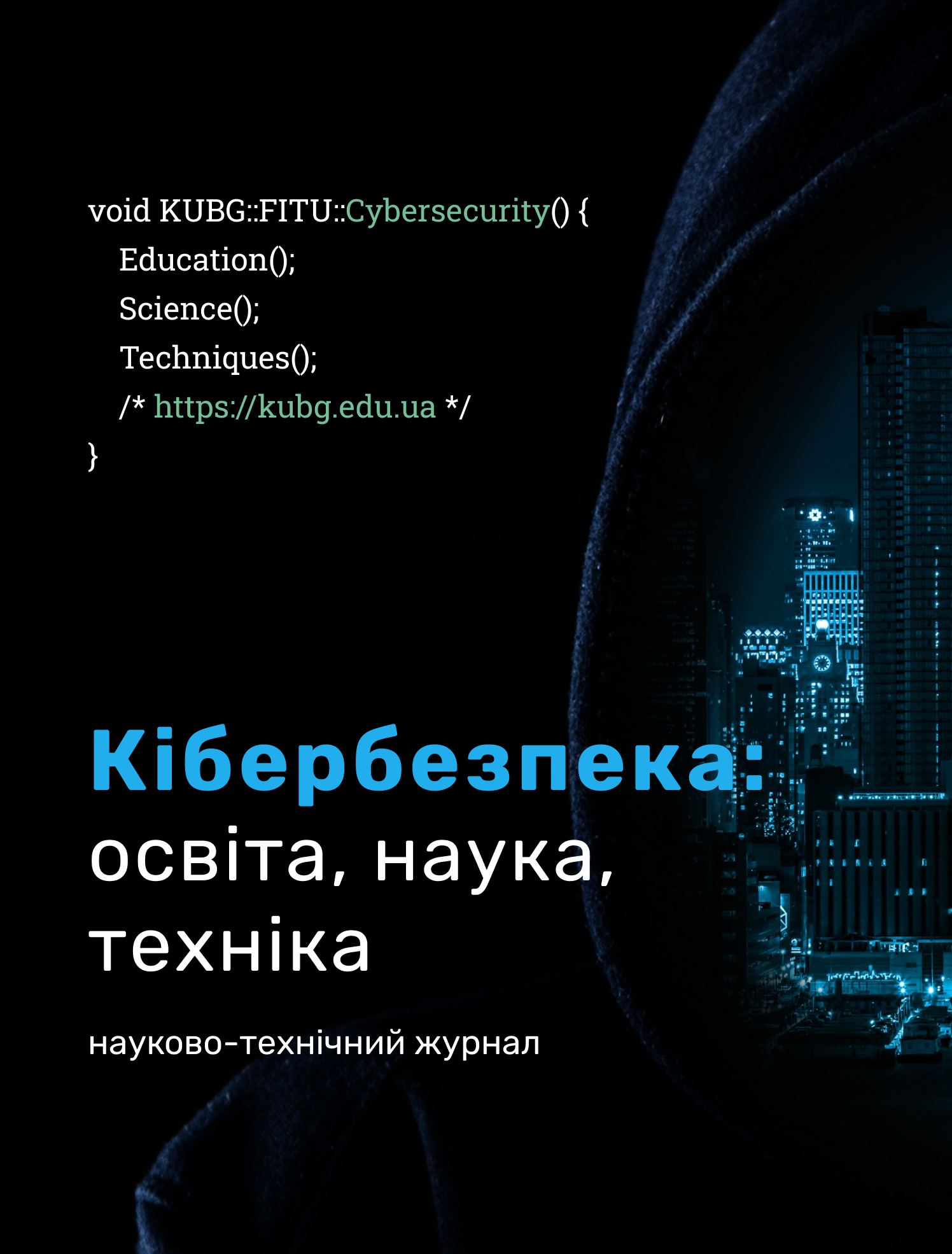MATHEMATICAL METHODS IN CIBERNETIC SECURITY: GRAPHS AND THEIR APPLICATION IN INFORMATION AND CYBERNETIC SECURITY
DOI:
https://doi.org/10.28925/2663-4023.2021.13.133144Keywords:
mathematical methods; cybersecurity; graph; attack graph; graph algorithms; cryptographyAbstract
This article is devoted to the problem of applying graph theory in cybersecurity systems and is an overview. Widespread penetration of mathematical methods in the development of information technology characterizes the current stage of our society. Among the mathematical methods used in information and cyber security, a large niche is graph technology. A streamlined system of special terms and symbols of graph theory allows you to easily and easily describe complex and subtle things both geometrically and algebraically. A graph is a mathematical model of a wide variety of objects, phenomena, and the relationships between them. This justifies the choice and relevance of this study. The article outlines the main elements of graph theory, the wide scope of their implementation and provides a historical perspective on the development of this theory. The analysis of scientific works allowed to determine the main directions of application of properties, characteristics of graphs and graph algorithms in information and cyber security. Among them are studies related to the use of graphs in information systems and programming; with modeling, analysis and application of attack graphs; with cryptographic transformations; with the construction of a decision tree in decision-making tasks in conditions of risk and uncertainty. It is proved that the ability to operate with the methods of graph technologies contributes to the development of software and hardware for information protection. The considered approaches to the application of graph theory in information and cyber security can be implemented during the study of the discipline "Special methods in security systems: discrete mathematics" for students majoring in 125 Cybersecurity, as well as in training in research or course work or thesis. By increasing the professional orientation of training, future cybersecurity workers gain a thorough knowledge of fundamental disciplines.
Downloads
References
Shevchenko, S., Zhdanovа, Y., Spasiteleva, S., Negodenko, O., Mazur, N., & Kravchuk, K. (2019). MATHEMATICAL METHODS IN CYBER SECURITY: FRACTALS AND THEIR APPLICATIONS IN INFORMATION AND CYBER SECURITY. Cybersecurity: Education, Science, Technique, (5), 31–39. https://doi.org/10.28925/2663-4023.2019.5.3139
Battista, G. D., Eades, P., Tamassia, R., & Tollis, I. G. (1994). Algorithms for drawing graphs: an annotated bibliography. Computational Geometry, 4(5), 235–282. https://doi.org/10.1016/0925-7721(94)00014-x
Kasianov, V.N., Evstyhneev, V.A. (2003). Hrafы v prohrammyrovanyy: obrabotka, vyzualyzatsyia y prymenenye. BKhV-Peterburh.
Danforth M. Models for Threat Assessment in Networks. http://www.cs.ucdavis.edu/research/tech- reports/2006/CSE-2006-13.pdf
Schneier, B. (1999). Attack trees, Dr. Dobb’s Journal of Software Tools.
Roy, A., Kim, D. S., & Trivedi, K. S. (2010). Cyber security analysis using attack countermeasure trees. У the Sixth Annual Workshop. ACM Press. https://doi.org/10.1145/1852666.1852698
Noel, S., Jajodia, S., Wang, L., Singhal., A. (2010). Measuring Security Risk of Networks Using Attack Graphs. IJNGC, 1(1), 135–147. https://scholar.google.com.ua/scholar?q=Measuring+Security+Risk+of+Networks+Using+Attack+Graphs&hl=uk&as_sdt=0&as_vis=1&oi=scholart
Matthews., I, Mace Newcastle, J., Soudjani, S., Aad van Moorsel. (2020). Systematic Computational Approach. arXiv:2005.06350v1 [cs.CR] 13 May 2020.
Ou, X., Boyer, W. F., & McQueen, M. (2006, 1 січня). (PDF) A scalable approach to attack graph generation. ResearchGate. https://www.researchgate.net/publication/313772274_A_scalable_approach_to_attack_graph_generation
Derbyshire, R., Green, B., & Hutchison, D. (2021). “Talking a Different Language”: Anticipating Adversary Attack Cost for Cyber Risk Assessment. Computers & Security, 102163. https://doi.org/10.1016/j.cose.2020.102163
Savchenko, V. A., Matsko, O. I., Legominova, S. V., Poltorak, I. S., & Marchenko, V. V. (2019). The Cyberattack Simulation by Graph Theory. Modern information security, (4). https://doi.org/10.31673/2409-7292.2019.040611
Doynikova, E. V., & Kotenko, I. V. (2018). Improvement of Attack Graphs for Cybersecurity Monitoring: Handling of Inaccuracies, Processing of Cycles, Mapping of Incidents and Automatic Countermeasure Selection. SPIIRAS Proceedings, 2(57), 211. https://doi.org/10.15622/sp.57.9
Fomychev, V. M. (2010). Metodы dyskretnoi matematyky v kryptolohyy. Dyaloh-MYFY.
Koreneva, A. M. (2010). O nekotorыkh rezultatakh systematyzatsyy teoretyko-hrafovыkh modelei, yspolzuemыkh dlia reshenyia zadach kryptolohyy. U XIV Mezhdunarodnaia telekommunykatsyonnaia konferentsyia studentov y molodыkh uchenыkh «MOLODEZh Y NAUKA» (s. 239–241). M.: NYIaU MYFY.
Priyadarsini, P. L. K. (2015). A Survey on some Applications of Graph Theory in Cryptography. Journal of Discrete Mathematical Sciences and Cryptography, 18(3), 209–217. https://doi.org/10.1080/09720529.2013.878819
Ustimenko, V. (2015). On algebraic graph theory and non-bijective multivariate maps in cryptography. Algebra and Discrete Mathematics, 20 (1), 152–170.
Amudha, P., Charles Sagayaraj, A.C., Shantha Sheela, A.C. (2018). An Application of Graph Theory in Cryptography. International Journal of Pure and Applied Mathematics, 119(13), 375-383.
Scientific American Article | Huffman Coding. (б. д.). Huffman Coding | … with a bunch of Family Stuff too. http://www.huffmancoding.com/my-uncle/scientific-american
Read, R. C. (1997). Graph Theory and the Amateur Cryptographer. Computers & Mathematics with Applications, 34(11), 121–127. https://doi.org/10.1016/s0898-1221(97)00226-5
Kupryianov, M.S., Shychkyna, Yu.A. (2012). Prymenenye teoryy hrafov dlia razrabotky priamoho metoda postroenyia derevev reshenyi, Systemы. Metodы. Tekhnolohyy, 4(16), 62-65. https://brstu.ru/static/unit/journal_smt/docs/number16/62-65.pdf
Ore, O. (1956). Hrafы y ykh prymenenye. M.: Myr.
Nydkhem, M., Khodler, Э. (2020). Hrafovыe alhorytmы. Praktycheskaia realyzatsyia na platformakh Apache Spark y Neo4j. DMK Press.Shrinivas, S.G., Vetrivelet, S., Elango, N.M. (2010). Applications of grapf theory in computer science an overview. International Journal of Engineering Science and Technology, 2(9), 4610-4621.
Published
How to Cite
Issue
Section
License

This work is licensed under a Creative Commons Attribution-NonCommercial-ShareAlike 4.0 International License.




